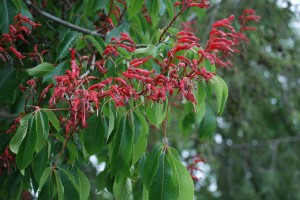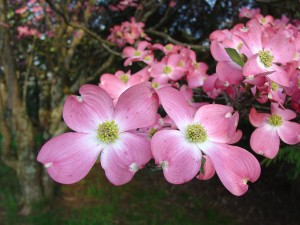This title is somewhat misleading. Deer will eat or sample (nibble) on any landscape plant, particularly if they are hungry enough. Deer also do not read lists of plants they’re suppose to leave alone.
The following list of deer resistant plants is a sampling from reports across the U.S. It does not include every tree reported. Deer species and numbers vary across this big country. A deer’s food palate may also differ from one region to another. It also depends on how hungry the numbers of deer in an area may be.
Some native trees such as American beech, buckeyes, green ash, persimmon, hophornbeam, and flowering dogwood are important food resources for deer and other wildlife. But, they do little significant damage to their host tree(s). If you are trying to introduce young host trees into a landscape, you should fence them off for 3-5 years until they become larger and better established. Finally, prune up low branches out of reach of deer feeding.
Abnormally high deer populations starved for a lack of their favorite foods (mast) will eat or browse on almost any plant. This is a survival reaction. To truly protect plants from deer when deer numbers are unusually high, a tall fence or reinforced netting may be your best options.
Deer Resistant Tree List:
Paperbark Maple (Acer griseum)
Japanese Maple (Acer palmatum)
Striped maple (Acer pensylvanicum)
Norway Maple (Acer platanoides)
Red Maple (Acer rubrum)
Sugar Maple (Acer saccharum)
Ohio Buckeye (Aesculus octandra)
Red Buckeye (Aesculus pavia)
Mimosa (Albizia julibrissin)
Downy Serviceberry (Amelanchier arborea)
Shadblow (Amelanchier canadensis)
Allegheny Serviceberry (Amelanchier laevis)
Pawpaw (Asimina triloba)
Himalayan Birch (Betula jacquemontii)
Yellow Birch (Betula lutea)
River Birch (Betula nigra)
Paper Birch (Betula papyrifera)
European White Birch (Betula pendula)
European Hornbeam (Carpinus betulus)
Deodar Cedar (Cedrus deodara)
Katsura Tree (Cercidiphyllum japonicum)
Chinese Fringe Tree (Chionanthus retusus)
Flowering Dogwood (Cornus florida)
Chinese (Kousa) Dogwood (Cornus kousa)
Winter King Hawthorn (Crataegus viridis ‘Winter King’)
Japanese Cedar (Cryptomeria japonica)
Leyland Cypress (Cupressocyparis x leylandii)
Persimmon (Diospyros virginiana)
American Beech (Fagus grandifolia)
European Beech (Fagus sylvatica)
Green Ash (Fraxinus pennsylvanica)
Ginkgo (Ginkgo biloba)
Honey Locust (Gleditsia triacanthos)
Carolina Silverbell (Halesia diptera)
American Holly (Ilex opaca)
Eastern Red Cedar (Juniperus virginiana)
Goldenrain Tree (Koelreuteria paniculata)
Tulip or Yellow Poplar (Liriodendron tulipifera)
Southern Magnolia (Magnolia grandiflora)
Dawn Redwood (Metasequoia glyptostroboides)
Eastern Hophornbeam (Ostrya virginiana)
Sourwood (Oxydendrum arboreum)
Spruces (Picea spp.)
Japanese Red Pine (Pinus densiflora)
Limber Pine (Pinus flexilis)
Eastern White Pine (Pinus strobus)
Flowering Cherry (Prunus serrulata)
Douglas Fir (Pseudotsuga menziesii)
Sassafras Tree (Sassafras albidum)
Bald Cypress (Taxodium distichum)



 Posted in
Posted in 
